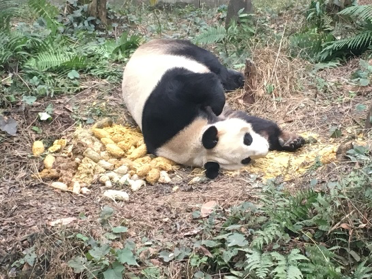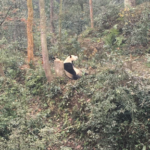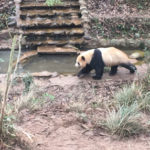Over the last week we’ve had a few new arrivals here at Bifengxia. Two of these newly arrived pandas are Na Na and Zhang Ka. I was fortunate enough to complete stereotypic studies on both of these ladies on back-to-back days allowing me to get the scoop on these newcomers and see just how different they are based on their new surroundings. When it comes to Zhang Ka, her new neighbor is Ge Ge, a female panda who is highly stereotypic and always full of surprises. However, Zhang Ka seemed completely uninterested in her new neighbor and fairly content with her new home. This came as a surprise as often times when a panda enters a new area you will see plenty of scent marking and exploration. Instead, Zhang Ka seemed uninterested and the only shock came when I observed her maneuver far back into her environment to reveal her sleeping place…in a bed of her own feces.
- Yang Yang trying to get a peek at Na Na
- Na Na relaxing at her throne
- An An pacing, excited about his new neighbor
Completely opposing this was my study with the second newcomer, Na Na. This is where the surroundings become key, at least in theory, of why there was such a discrepancy in the amount of behaviors observed in Na Na and Zhang Ka. Na Na is neighbors with two male pandas, An An and Yang Yang, and it was clear this was quite a treat for Na Na. Throughout the study she would quickly maneuver about, exploring her new environment while also checking out her new neighbors who were both frequently stereotyping and vocalizing. Na Na didn’t seem too interested in An An but did stop by to communicate with Yang Yang for quite a bit. This was a huge victory for Yang Yang, who began to sprint around excitedly but Na Na. quickly grew bored and settled down in what I declared to be her throne (a stump she would sit against while pondering the meaning of life). These two days of studies really bring to mind the question of whether Zhang Ka would’ve had more distinct behaviors to record if the situation would’ve been flip-flopped and she had been next to two male pandas. Opposing this, maybe Na Na would have been just as energetic and explored as much if she had been next to Ge Ge, who normally is very interactive with her other neighbor Xiang Lin.
 Hi- I’m Zachary Steele. If you have any questions, feel free to post them in the comments below. Thanks for reading!
Hi- I’m Zachary Steele. If you have any questions, feel free to post them in the comments below. Thanks for reading!





Hi Zachary, would you please define what is stereotypical behavior – is that something expected of all panda in the same situation? I’m sorry I’m so woefully uninformed but I’m “new” to the panda world. Thank you for your observations and insights!
Hi JoAnn,
Forgive me for jumping in for Mr. Steele.
As defined by Georgia J. Mason, who is considered an authority on stereotypic behavior (Stereotypeis: A Critical Review), Stereotypies are repetitive, invariant behaviour patterns with no obvious goal or function. I highly recommend reading this as it is very informative on the issue.
Your second question- Is this something that is expected in the same situation? Any captive situation could illicit stereotypes, but it’s poorly understood as to why certain animals have them. Stereotypies are seen only in captivity. But, this is part of our study… To investigate who is/isn’t stereotypic and how this affects breeding and cub production.
We are currently working on these questions and will hopefully be able to get our results out in a timely manner. So stay tuned.
Great Questions!
Thank you for the answer, Nathan, and the reading recommendation – I will try to find it on Amazon as soon as I finish this message. Someone in my Facebook panda group said that the panda engaged in repetitive behavior when he or she was frustrated – it was a way to calm their angst! Mei Xiang an BaoBao and now BeiBei at SNZ do a “dance” when they want a treat or want to go out! I will now look at this behavior differently. Thank you for your insight! Have a great day!.
This is a good report with good information explaining what you did. My question is this… Will you put Zhang Ka between the two males to see how she behaves? Also during breeding season, will you continue to give female pandas the choice in males by placing them between two males?
Charlene,
Yes! We will absolutely continue our male-male competition study starting in mid-February with the winter interns. It sounds like Zhang Ka will probably be part of this study if she’s still at BFX! We track locations of the bears throughout the year and hope to investigate the effects of “long-term” neighbor familiarity on breeding success as well – should be interesting and we’ll keep you posted.
FYI, Zhang Ka’s daughter, Zhang Meng’s father is Yang Yang. It will be interesting to see whether Zhang Ka is attracted to Yang Yang the next time around. C.
I guess there are many reasons for which pandas behave differently in what seem to be similar circumstances.
Na Na was born in captivity and from what I understand, she has been moved several times in the near past. That could explain why she was checking her surronding more.
Zhang Ka was wild born and she just finished raising her daughter Zhang Meng who was released into the wild at Liziping Nature Reserve on October 20, 2016. Perhaps she has decided that she needs a break!
Keep up with the good work!
Is this where the Mei’s are that usta b @ ZooATL? …. How is it decided where the pandas go upon their return to China? … SO NOT looking forward to #MyChriamaQUEENBao leaving SNZDC… She is my very fav & I wud like to follow and see her! XO
We’ll definitely try to keep everyone updated on pandas if they get moved to the CCRCGP bases. Bao Bao is super precious and we’d love to see her in our studies but she won’t be moved until sometime between 4-6 years old (most US pandas get shipped back around 4 years of age). Thanks for following us!
The Mei’s from Zoo Atlanta are at the Chengdu Panda Base in Chengdu.
As you know, the Smithsonian National Zoo has announced that Bao Bao will make her way to China sometime late February 2017. Bao Bao will most likely go to CCRCGP Dujiangyan facility for quarantine 1st before she is moved to whichever facility CCRCGP decides.
Is this where the Mei’s are that usta b @ZooATL? How is it decided where the pandas go when the return to China? Sadly, My fav , or as I call her #MyCharismaQUEENBao from SNZ will be returning soon and I wud like to keep up with her and see pic of her from time to time…
Joy, the Mei’s were moved to Chengdu base. Zoo Atlanta mainly works at Chengdu and where the parents are loaned from determines their return base. SNZ bears are from Wolong so chances are we’ll be seeing Bao Bao in the future. We definitely see Tian Tian a couple times per year so chances are good you’ll be able to follow Bao Bao on our blog.
Hi Zachary, I’m a panda fan but barely know anything about animal behaviors. May I ask that are all stereotypies bad for animals? I know a 1-year old panda cub who likes to lick her claws and belly after meal (, usually lasting half an hour). Meanwhile, she looks not depressed but very energytic and is always exploring her yard. I don’t know whether her licking behavior is a bad stereotype or just harmless. I love her and I’m worrying about her. Hope you can respond. Than you very much.
Hello Panda,
This is a great question, and I apologize for answering on Zack Steele’s post. The prevailing hypothesis is that stereotypes should not necessarily be viewed as “bad”, as it has been shown that these behaviors are largely a coping mechanism. Stereotypic behaviors, however odd they might seem, could help the bears by lowering their cortisol (stress) levels. This and other potential ideas are extensively written about by Georgia Mason. Here is a link to her popular stereotypic research article-
Georgia Mason Stereotype Paper
We are currently analyzing our mountain of Stereotypic data and will hopefully have more to say on this in the near future.
As for the cub licking her claws and belly… I hesitate to call the behavior you mention as stereotypic for multiple reasons.
1) Stereotypes are highly variable across bears and time (cub to adult)-
2) It is difficult or impossible to say without personally observing the bear. However, it sounds like she might be cleaning herself.
I hope this helps to shed a little light on the topic.
Thanks for commenting!